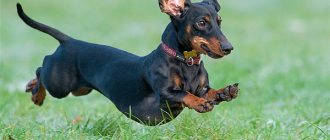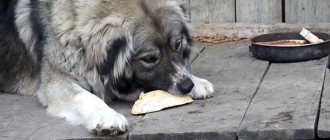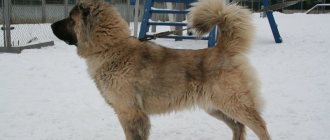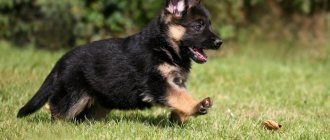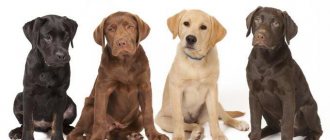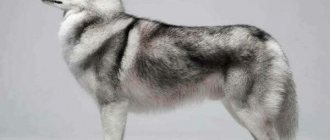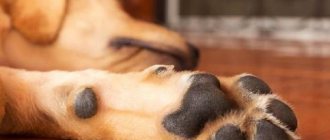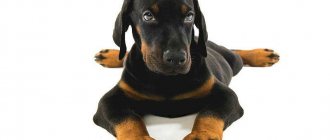Caucasian Shepherds are considered one of the largest dogs in the world, and their weight and size often exceed standard ones. The main thing that is required of the owner when raising and keeping a pet of this breed is to ensure that the weight and height of the animal are in the correct ratio and are not lower than the minimum standard limits.
Height and weight chart
| Age | Male weight (in kg) | Bitch weight (in kg) | Male height (in cm) | Bitch's height (in cm) |
| 1 month | 4-6,8 | 2,5-4,5 | 24-26 | 23-25 |
| 2 months | 13-19,6 | 11,5-18 | 34-37.5 cm | 33-35.5 cm |
| 3 months | 18-32 | 16,5-30 | 45-49 | 43-46 |
| 4 months | 25-60 | 22-50 | 51-55,5 | 48,5-51,5 |
| 5 months | 35-64 | 32-60 | 57-62,5 | 54-57 |
| 6 months | 40-94 | 35-92 | 63-68 | 59-63 |
| 7 months | 41,7-99 | 35,7-96,2 | 64-70 | 60-65 |
| 8 months | 43,4-104,4 | 36,5-100,6 | 65-72 | 61-67 |
| 9 months | 44,8-109,5 | 37,2-104,8 | 66-74 | 62-69 |
| 10 months | 46,2-114,6 | 38-109 | 66,5-75 | 63-70 |
| 11 months | 47,6-125 | 38,6-113,2 | 67,5-76 | 63,5-71 |
| 1 year | 50-125 | 40-115 | 68-78 | 64-72 |
How much does a Caucasian Shepherd dog weigh?
The spread in the parameters of this breed between the standard and the real one can be significant and increasing. It is important for the owner that his pet does not go beyond the minimum level.
If the animal’s weight exceeds the maximum, you need to make sure that the dog is really large and not overfed. To do this, compare the parameters of height and volume of the metacarpus. They must also not exceed the standards.
If the difference between real indicators and standard ones is significant, this indicates improper maintenance of the animal (underfeeding or overfeeding), deviations in the health of the animal - the presence of diseases. In these cases, you need to contact an experienced veterinarian.
From birth to 2 weeks
The initial stage of development begins at birth and lasts up to 7 weeks. The birth weight of Caucasians should be between 0.6 and 0.8 kg.
If a newborn kitten weighs less than 600 grams, it is simply naive to hope to get a large dog from it in the future.
An overly large puppy is also not a guarantee of its health. Before purchasing a pet that was born weighing more than 800 g, you must consult a veterinarian about congenital abnormalities in the animal.
Rapid growth in the first weeks of life is ensured by nutritious mother's milk
A newborn litter is small lumps, compact and inactive. They are active only when there is discomfort: experiencing hunger, dampness, cold, or painful sensations. At this time, the chicks have developed taste, smell, vestibular apparatus and skin-temperature reflexes.
Therefore, at first the little Caucasian is helpless, sleeps a lot, and often latches onto his mother’s nipples. The main food for him is milk. If the bitch has good lactation, and the litter is viable, which is expressed in its activity during sucking, then the daily increase from birth to four weeks of age is 113-200 grams.
Caucasians grow rapidly during this period. By two weeks they weigh from 2000 to 3880 g.
1 month
The period from 15 to 30 days is very important for dogs. At this time, auditory and visual perception of the world develops. Puppies begin to learn about objects around them. By this time they can already walk.
The height at the withers for girls should be at least 23-25 cm, for boys - 24-26. Measurements of the metacarpus during this period in females show 8-9 cm. In males, these figures are half a centimeter higher.
One-month-old young animals can already be given liquid complementary foods as an additive to mother's milk. Average weight from 4000 to 6800 grams. Moreover, girls have less mass than boys.
After a month, puppies continue to need mother's milk, but are already receiving their first complementary foods.
2 months
During this period, puppies begin to gain 400-420 grams daily. The weight of a two-month-old Caucasian Shepherd is from 13 to 19.6 kg.
Puppy age 2 months
3 months
For now, Caucasians are still clumsy and clumsy. But they are no longer as compact as newborns. Their limbs become elongated, their neck and torso become more oval, their head and chest enlarge. During this period, the Caucasian Shepherd puppy looks like a small bear cub.
The baby begins to develop conditioned and conditioned-unconditioned reflexes. At this time, it is recommended to begin training your pet, instilling basic skills in it, and teaching it simple basic commands.
He is still growing rapidly, gaining weight, and actively maturing. The daily increase ranges from 200 to 400 grams. A three-month-old puppy should weigh 18-32 kilograms.
The height at the withers according to the standard for females reaches 43-46 centimeters, for males - 45-49 centimeters. The volume of the metacarpus in girls is 11.5-12.5 centimeters, in boys the figures are 1 centimeter higher.
3 months - time to start actively training the puppy
4 months
From the age of three months to six months, the weight of a Caucasian Shepherd puppy should increase three times. During this period, the daily gain varies from 230 grams to 530. The weight of a four-month-old puppy can be 25-60 kilos.
Puppy age 4 months
5 months
The maximum weight of a five-month-old Caucasian is 64 kg, the minimum is 35 kg. It is already acquiring its basic color - the period of juvenile molting is ending.
The teenager's molars begin to grow, and his ears gradually rise. The pet is almost completely similar to an adult.
Puppy age 5 months
6 months
A six-month-old puppy weighs 40-94 kilograms. Its height at the withers reaches 63-68 cm in boys, 59-63 cm in girls. The volume of the metacarpus in females reaches 13-14 cm, in males - 14-15.5 cm. Now its appearance almost completely corresponds to an adult.
At this time, young bitches may begin their first heat. But dog experts and veterinarians do not recommend breeding large breed dogs until they are 2 years old. It is then that the bitch’s body completely matures.
Puppy age 6 months
7 months
After six months, animals grow less actively. In four weeks they gain from 1700 g to 5160 g. Daily gain varies from 57 to 172 g. A seven-month-old Caucasian weighs 41.7-99 kg. According to standards, the norm is 40-70 kilograms of live weight of the animal.
8 months
An eight-month-old individual weighs from 43.4-104.4 kg. The difference between the minimum and maximum indicators is explained by the parental genes, the health of the dog, its maintenance: feeding, used when exercising dogs with physical activity.
9 months
A nine-month-old adolescent shepherd can weigh between 44.8 kilograms and 109.5 kg. This is an almost fully formed individual. The animal is still growing, although not as rapidly as before.
10 months
Most of this breed grows to ten months of age. Having reached it, the pet looks like an adult.
A ten-month-old male dog can weigh a minimum of 46.2 kg, and a maximum of 114.6 kg.
At 10 months, a Caucasian Shepherd puppy looks like an adult
11 months
Some shepherds gain a little weight up to three years of age. This happens because with age, bones become stronger and muscles become denser. Therefore, even with identical volume parameters, the animal turns out to be heavier when weighed. The minimum weight for a male is 47.6 kg, for a female - 38.6.
Year
From six months to a year, the weight of a Caucasian Shepherd dog increases by only a third. The norm for females is 40-115 kg, for males - 50-125 kg.
The height of the Caucasian Shepherd at the withers for males becomes 68-78 cm, for females – 64-72. The volume of the metacarpus in girls reaches 14-15 cm, in boys - 15.5-16.5 cm.
From one to three years
The age of the shepherd is 2 years.
At one and a half years, the puppy’s growth stops, but its weight may increase a little more. According to standards, an adult Caucasian Shepherd weighs 45-50 kg.
But today there are increasingly deviations towards increasing the parameters of representatives of this breed. Very large individuals are often encountered.
Sometimes the weight of an adult Caucasian Shepherd Dog reaches 125 kg. This happens thanks to the selection work of breeders.
Up to 2 weeks after birth
At birth, puppies weigh between 600 and 800 grams. If a baby weighs less than the minimum limit, then he is unlikely to be able to grow into a large dog with strong bones and voluminous muscles. But puppies weighing more than 800 grams can turn out to be problematic in terms of health and, moreover, significantly outgrow the standard.
Newborn babies are inactive: they sleep most of the time and eat very often. At the same time, their daily weight gain ranges from 113 to 200 grams.
By the age of two weeks, the body weight of puppies is 2000–3880 grams.
Coat
The coat of the Caucasian Shepherd consists of three components: undercoat, guard hair and outer coat.
The undercoat consists of thin, soft-to-touch hairs that resemble down. It performs a warming function. Basically, the undercoat is clearly visible, but can be of different densities, depending on the conditions of detention and the influence of seasonal molting.
The guard coat is thick, straight, and rough to the touch. It is the main part of the coat and is evenly distributed throughout the dog’s body. The largest number of guard hairs is located on the back.
Cover hairs are rare, but distributed throughout the body of the Caucasian Shepherd. There are pores around each hair, the function of which is to saturate the animal’s skin with oxygen.
One of the largest dogs in the world has three types of hair:
- long (up to twelve centimeters, with a mane, feathering on the limbs, “pants” and a well-furred thick tail);
- intermediate (medium length, no fringes or “pants”);
- short (up to seven centimeters, without the presence of a mane, fringe or “pants”).
First month
Over the next two weeks, the shepherd pups begin to comprehend the world around them with the help of sight and hearing, and also gradually walk. By the thirtieth day of life, the height at the withers in boys of this breed is at least 24, and in girls it should be at least 23 cm. The weight of one-month-old puppies is 2500–6800 grams, while girls weigh less than their littermates.
Health
Caucasian Shepherd Dogs are distinguished by excellent health and it is not surprising: for hundreds of years the dogs led a nomadic life and adapted themselves to any weather conditions. However, the breed has a risk of diseases of viral origin. They develop if the enclosure is dirty. Therefore, it is very important to regularly clean the pet’s place of residence and clean the enclosure using disinfectants once every few months.
Large breeds have a tendency to dysplasia - destruction of the bone tissue of the hip joints. This disease occurs due to poor heredity, with an inactive lifestyle and in show animals. In severe form, the pet experiences severe pain when trying to move. In such cases, the dog loses the ability to move at all and dies from this.
Advice! It is better to take a puppy from a breeding kennel. Breeders must be required to provide all documents about their parent dogs.
They are not even a month old
3rd month
Outwardly, at this age, small shepherd dogs become similar to bear cubs. They are still clumsy, but their legs have noticeably elongated, and their heads and chest have become more voluminous.
At three months of age, daily weight gain is 200-400 grams.
By the third month of life, the puppy weighs 18-32 kg, and the height at the withers is 45-49 cm in boys and 43-46 cm in girls. From the age of three months, the shepherd dog begins to develop conditioned reflexes, and this is the time that is considered the most suitable to begin systematic training of the pet.
Head
The wedge-shaped shape of the dog's head ends with a wide base. The large and voluminous skull has an almost flat frontal part, which is divided in half by a shallow groove. The bump on the back of the head and the transition from the muzzle to the forehead (stops) are not particularly noticeable. The chewing muscles are well developed.
The large, wide, black nose does not protrude beyond the lines of the muzzle. The nostrils are moderately open.
The dog's voluminous muzzle tapers towards the nose. Its top line is parallel to the line of the forehead. Under the eyes, the animal's muzzle is well filled with well-developed muscles. The shepherd's muzzle ends with a powerful lower jaw and chin. Voluminous lips have distinct black pigmentation.
The standard allows for both scissor and level bites in Caucasian Shepherds. Typically, a complete set of teeth requires the presence of forty-two white teeth that are closely spaced together. Broken, knocked out teeth, missing first premolars (maximum two) are considered normal, but only if these flaws do not interfere with the determination of the bite.
The animal's eyes are of medium size, deep-set, wide and oblique. Black eyelids fit tightly to the eyeballs. Eye color can vary in intensity: from dark brown to hazel. The world's largest Caucasian dog always has a serious and attentive look, assessing the surrounding situation every second.
Small ears in the shape of a triangle hang on cartilage, and their inner part is very close to the dog's head. The ears are quite thick to the touch. Traditionally, they are docked (part of them is cut off). But the standard also allows uncropped ears.
The low-set neck of the animal is of medium length. The neck muscles are well developed. In males, the scruff of the neck is clearly visible.
From 1 year to 3 years
After one and a half years, the dog’s growth stops, but body weight can continue to increase until the age of three, until the animal reaches the full flowering of its physical development.
According to the breed standard, the average weight of an adult representative of this breed should be from 45 to 50 kg.
But in some very large dogs it can be 90 kg or more.
Temperament
The world's largest dog from the Caucasus has all the necessary protective qualities: poise, confidence, courage, independence, and the ability to make its own decisions at a crucial moment.
The Caucasian Shepherd is infinitely loyal to its owner and his family and is ready to protect its “pack” from enemies until the end of its days. Always hostile towards strangers, but can restrain his impulse on the orders of the owner.
What to do if it lags behind the norm?
Owners of Caucasian Shepherds should understand that each puppy is an individual and that all babies grow differently. If the shepherd dog continues to grow and develop, then there is a high probability that he will soon gain the missing weight. When we are talking about an adult dog or the gap from the norm exceeds 10% of the recommended weight, it is necessary to find out why this is happening.
The most common causes of weight loss:
- Heredity. If the puppy's parents are not large in size, then it is naive to expect that he will outgrow them. Also, the fact that the puppy is slowly gaining weight may be due to hereditary reasons. To make sure this is the reason, contact the breeder and ask how quickly your pet's mother grew and gained weight when she was the same age.
- Incorrect cultivation. It happens that a recently purchased puppy weighs less than normal. In this case, the cause of weight loss is often due to improper rearing in the breeder’s home. To solve this problem, it is best to consult a veterinary clinic, where experts will tell you how to feed the puppy correctly so that it quickly gains the missing weight.
- Illness or infestation by internal parasites. During illness, dogs often lose weight. If your pet has recently been ill with something serious, he may lose a lot of weight. In this case, it is recommended to contact a veterinarian to help you choose a more nutritious food for your pet or develop a natural feeding diet, and, if necessary, recommend antihelminthic medications.
- Insufficient physical activity. If a growing dog moves little, it cannot grow and develop properly, which can also cause weight loss. To solve this problem, it will be enough to devote more time to physical training of your pet.
Artificial methods of replenishing weight loss, in particular, adding supplements to the dog’s diet to increase muscle mass or strength training, such as running in a harness with weights, are completely unacceptable. Not only do they not contribute to the harmonious development of the pet, but they can also cause serious health problems.
List of prohibited products
After we have figured out the diet of Caucasian puppies, it will be useful to familiarize yourself with the list of foods that are contraindicated for puppies. This will allow you to avoid unpleasant situations when your pupil’s health may be in danger.
So, it is not recommended to give small Caucasians the following types of food:
- Pork meat - it is too fatty and can lead to intestinal upset;
- River fish – they contain parasites;
- Tubular bones - they can cause injury to the palate, gums and digestive tract;
- Sweets, spicy and salty foods;
- Poor quality dry food;
- Spoiled products - they can cause poisoning;
- Frozen food;
- Butter rolls, freshly baked bread;
- Potatoes, onions, spices.
Preliminary information
The exterior of Caucasians begins to form immediately after birth - this process lasts a whole year and ends at approximately 12 months. From 1 to 7 months the most rapid development occurs, so at this stage it is especially important to organize the correct regime and feeding of the Caucasian Shepherd.
A well-designed menu implies the presence of all the necessary nutrients, an optimal balance of carbohydrates, proteins and fats, as well as the quality and variety of food.
When choosing what to feed your Caucasian Shepherd puppy, always focus on how he perceives the food offered and how his body reacts to it. If you notice that your pet is not very willing to eat or your menu has a bad effect on its health, consider replacing it with a more acceptable type of food.
In any case, when picking up your baby from the breeder, ask what he was fed there - first you will have to adhere to the same scheme and the same diet. You cannot suddenly switch your puppy to a different diet - this can cause severe stress in the body. Only after a month can you begin to gradually change the regime and menu - this will give the baby the opportunity to endure the changes without unnecessary worries and worries.
Both puppies and adult dogs are fed according to three schemes:
- Premium dry food for large breeds;
- Natural food;
- Complex nutrition combining dry food and natural ingredients.
At the same time, do not forget that the dog should always have dishes with clean, fresh drinking water - pour spring or filtered water into it.
Feeding two month old babies
Let's now talk about how to feed a Caucasian Shepherd puppy under three months of age. After weaning and transporting him to a new place of residence, give him the food that he received from the breeder. Then gradually begin to introduce new foods to the menu - if the puppy refuses, there is no need to force him, perhaps it is just stress from separation from his mother.
During this period, feed the dog 5 times a day - then the number of meals will need to be reduced and the volume of portions increased. Before the four-month mark, dry food must be soaked in milk or water.
Build your diet on various cereals - oatmeal, buckwheat or wheat porridge. You can add minced meat, chicken or turkey meat, eggs, and vegetable fats. In the morning you can give cottage cheese with a complex of vitamins or semolina cooked in milk - put a spoonful of honey or half a hard-boiled egg there. Later, you can give a raw egg once every two days. Kefir, yogurt, fermented baked milk or sour cream will also be very useful.
Porridges need to be boiled thoroughly - this is necessary so that they are better absorbed. It is recommended to cook them in meat broth, and add boiled minced meat or veal, beef or chicken meat cut into small pieces to the finished porridge. The norm up to three months of age is approximately 250-300 g.
The daily menu of a Caucasian of this age is as follows:
- In the morning - dry food soaked in milk, 1/2 a boiled egg and cottage cheese with a spoon of honey;
- Second breakfast - cottage cheese with sour cream or boiled vegetables with meat;
- Lunch - porridge with meat broth, grated vegetables, boiled minced meat or chicken;
- Afternoon snack - milk-based dry food;
- Dinner - small pieces of boiled meat mixed with porridge in vegetable oil, grated boiled vegetables.
Important Tips
Puppies should not be fed the following foods:
- pork, lard, sausages;
- spicy, smoked, pickled foods;
- baked goods, sweets;
- citrus fruits;
- legumes.
Your pet should always have clean drinking water. It is necessary to ensure that the food is not very cold or hot. Cartilage or spongy bones are not food and are perceived by the puppy as a tasty toy. The freshness and quality of the products used should be correctly determined; it is better to throw away uneaten leftover food.
When using ready-made food, you must choose at least premium brands designed specifically for large breed puppies.
Contrary to popular belief, Caucasians eat and drink relatively little, while remaining strong and healthy. Compliance with the recommendations for volume, frequency, balanced nutrition and quality of food will allow the puppy to grow into a beautiful large dog with good health and a stable psyche.
Sources of essential substances
A pet can receive the substances necessary for growth and development by feeding it both on a natural diet and on ready-made industrial feeds. If you have any doubts about what to feed a Caucasian, you need to consider the following. Caucasian Shepherds are not prone to allergies and have a stable digestive system, so it is better to choose natural products. This feeding method is more economical, but more time-consuming and requires a certain ratio of basic substances in the diet.
Squirrels
Protein food is the basis for the formation of a healthy body and has a beneficial effect on the development of powerful muscles. The main products containing protein are:
- meat and meat products;
- dairy products;
- eggs;
- fish.
Meat is a natural and favorite food for dogs. Little Caucasians should be offered raw beef, boiled rabbit or chicken. It is better to distribute the daily amount of meat over several feedings. Instead of meat, you can give offal 2-3 times a week. It is allowed to add blood from slaughtered animals to the diet. Within a few hours after slaughter, blood can be used in its raw form (except pork). Blood contains beneficial amino acids, has an antimicrobial effect, and prevents iron deficiency anemia.
Fish should be given no more than 2 times a week. Each portion of fish should be larger than the meat portion, which corresponds to the age of the dog. The puppy can be fed raw or boiled sea fish. River fish must be boiled. Before feeding, make sure there are no bones.
The yolk of a raw egg is usually mixed in milk. Sometimes you can give boiled protein or an egg in the form of an omelet.
Possible problems
The reasons why a pet eats poorly can be divided into two groups:
- psychological;
- physiological.
The first group includes the anxious or nervous state of the animal. Perhaps you are away from home too often and your dog is getting bored. Or the calm and measured life of a pet was disrupted by a sudden move or arrival of people unfamiliar to him. A dog may not eat well even during heat.
The second group includes such things as indigestion, scratches in the mouth, for example, from bone fragments, and the presence of parasites (worms). An animal does not eat well when it is sick. For example, the cause may be malfunction of the thyroid gland, complications of cardiac activity, kidney or lung disease, or cancer.
Also, the Caucasian Shepherd may begin to eat poorly if it has experienced severe shock or is in pain. In hot weather, your dog's appetite may also decrease.
If you notice that your dog is not eating well, be sure to take action. First of all, watch her. Perhaps the animal simply ate something from the ground and will have an appetite for its next meal. Try not feeding your pet for 24 hours so that he gets hungry. Access to clean water is a must.
If after a day the Caucasian Shepherd’s appetite has not returned, and she herself looks lethargic, immediately show the dog to the doctor. Most likely she got sick.
How to calculate the amount of food
How to check whether the diet is well balanced, whether the dog eats the norm or goes hungry? There is one way to overcome all doubts. The puppy is weighed every week. The speed at which he gains weight is the best indicator of proper feeding.
To keep the puppy occupied, he is given cartilage, which he happily chews on for several hours. You can also purchase a bone made from dry and compressed tendons at a pet store. It is necessary to prevent the dog from gaining excess weight at any age. Obesity leads to diseases of the joints and musculoskeletal system. First of all, make sure that such a misfortune does not happen to a teenage puppy before he has yet turned into an adult dog.
Diet
At different stages of its growth, your pet will require different diets:
- Babies eat quite often per month - breeders usually feed them about 5 times a day;
- At 2 months, puppies are gradually transferred to four meals a day;
- At 3 months, they gradually transition from four meals a day to three meals a day;
- 6-8 months - three meals a day;
- Up to a year, the dog is transferred to two meals a day;
- After a year, gradually teach your child to eat once a day - this is how adults eat.
In this case, you should get a table that shows the average weight of a puppy at different ages - compare the number of kilograms your pet gains per month with the average statistical data for this species.
Of course, a puppy’s weight may differ from classical standards - do not forget that this is a living creature that is difficult to fit within the parameters and requirements. However, the general trends should still persist - if this is not the case, consult your veterinarian.

